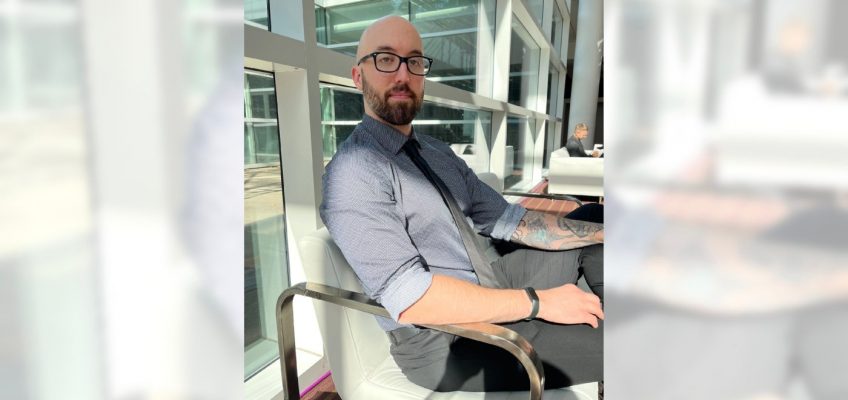In the middle of a conversation about “Clown Town,” the new Slow Horses novel, author Mick Herron reveals a bit of previously untold lore about the origins of Slough House.
Referring to a team of older spies who appear in the just-published book, Herron says, “Their careers never really went in the direction that they should have, very similar to the way the Slow Horses have been treated,” the latter referring to his recurring cast of misbegotten MI5 agents. “But of course, this is way back when Slough House itself didn’t exist at the time they were on active duty, so there was never any chance that they would have been sent there.”
Balancing gripping espionage, office tensions and Herron’s deeply funny prose, the Slow Horses books focus on M15’s fictional Slough House unit: the career dead-end for screw-ups, ne’er-do-wells and the odd spy who’s just had a bit of bad luck.
But wait, Herron doesn’t share how Slough House got started in the books, does he?
“I don’t; I’ve never specifically stated it. But I’ve always felt, and I don’t think I’ve stated this either, that it came into being with Jackson when it started,” he says. “Slough House was made for him, as it were, rather than him taking it over. I don’t think it was around before he was.
“It’s not something I’ve examined, but that’s certainly my feeling about it. I may have made allusions to that. I’ve certainly never gone into any detail about it,” says Herron.
Jackson, of course, refers to Jackson Lamb, the brilliant, bilious spymaster who runs Slough House. Though his motives are often as murky as the foul air in his office, Lamb seems to be keeping the nation safe by burying his team in pointless paperwork and isolating them from actual spywork – except when things have gotten so bleak that the Slow Horses can’t possibly make things worse. Until they do.
In a conversation edited for length and clarity, Herron, a warm, generous conversationalist, spoke by phone from Oxford, England, about the new book, his characters and how Rolling Stones frontman Mick Jagger came to sing the theme to the Apple TV+ streaming series, which returns for a fifth season on Sept. 24.
Q. How do you describe the new book “Clown Town” for people who haven’t read it yet?
It’s about a bunch of older spies who were treated badly, they feel, in terms of what they were asked to do, the operation they were asked to to take part in many years ago, a morally dubious operation, and are seeking some kind of reparation for what they went through. That, for me, is the core of the book.
Apart from that, it’s the Slow Horses doing what they always do, which is bicker amongst each other and make a bad situation worse.
Q. Do you find yourself doing a lot of research to write the novels?
If I find an interesting nugget of information that I can use, I’m going to use it. But I really write to mood and tone more than to anything else. I have quite deliberately deprived my characters access to any high-tech stuff so I don’t have to worry about that.
And I have invented a character in Roddy Ho who can do things on the computer, and that’s all I need to know. So I can have him do stuff I wouldn’t know how to go about doing, but I believe it’s possible to do it, and therefore he will be able to do it for me.
Q. Let’s talk about Roddy, the computer genius: He’s awful and self-deluded, but you somehow manage to make him sympathetic and entertaining to spend time with.
I think this is largely due to reader empathy more than anything else. One of the wonderful things about reading is that it does give you insight into other lives, other states of being. I don’t try to make him less awful, and I don’t try to make the reader love him. I just know that readers do extend their sympathy to characters, unless they’re outright evil.
You wouldn’t want to work at the desk next to him, but it does make him fun to read about, because you can let yourself go and just enjoy the ego trip that he’s on, but also recognize that there’s a sadness there, because Roddy genuinely doesn’t appreciate what an awful person he is.
ALSO SEE: ‘Slow Horses’ author Mick Herron says, ‘My heart is with those who struggle’
Q. In the new book, you say Jackson Lamb looks like “a sleeping bag someone had stuffed with potatoes,” among other descriptions I won’t spoil. Is it challenging to find fresh ways to describe characters?
I have to not repeat myself and I’m never totally confident that I’m not doing that. I don’t have total recall on every word I’ve ever written. It’s work and it’s fun at the same time. I mean, I enjoy it when I come up with something like, “sleeping bag someone had stuffed with potatoes.” I don’t recall laboring long and hard over that one.
I’m very hesitant about talking about this, in a way, because it’s not something that I analyze while I’m doing it. It’s something that I look on retrospectively and try to find reasons for how I do what I do, whereas, in fact, in real life, I simply do it to the best of my ability and keep my fingers crossed.
Mick Herron’s Slough House novels. (Courtesy of Soho Press)
Q. The recurring character Peter Judd, an amoral political insider, might have at one time seemed a little buffoonish or over the top, but now seems like he could have a plausible career.
Yes, it is quite frightening the way that certainly over the past decade and a half, characters whom we might quite rightly have considered buffoonish when they first appeared on the political landscape are, in fact, as it turns out, very, very dangerous, very despicable, and are doing an awful lot of damage to our various Commonwealths. So yes, it gives me no pleasure to think that there was any prescience involved in creating a character like that.
Q. Your characters haven’t always survived in previous books. Do you plan that out ahead?
I don’t ever have a full plan in place for each book, but when I start writing a book, I vaguely know where I’m going. I have a few plot points along the way. The daily work is a matter of getting from one point to another, so that the plot moves forward. If the character is going to die, then I know that right from the start.
In a way, it’s all sort of one big exercise in self-justification: I decided this is going to happen, and therefore I’m going to make all the other things happen that will allow that to take place. I don’t take pleasure in killing characters off, but I feel that it would be untrue to the book that I have in mind, the shape of the book, the color of the book, if you like. I sometimes think of them in terms of colors. It would be untrue to that original impulse if I started saying, I don’t really want to do that; I’d rather not kill a character off.
Q. You said you think about the books in terms of colors. Would you talk about that, please?
In the earlier days, I certainly did think of them in terms of colors. It’s a mood thing, really – and what kind of mood I was going to be in. Don’t ask me to say what they were, because I can’t remember, but I do know I felt it quite strongly. I haven’t done that so much lately, and it doesn’t seem to be a thing with me anymore.
Q. As you’ve been writing the series, have you developed a process for approaching each book?
It’s probably true that a lot of the, I don’t know what you want to call them rituals or superstitions, that are attached to writing a book, you could probably dispense with them, but they come to feel like scaffolding, in a way. You’ll know that my intros to a book are always the same for the Slough House series, and I would find it very difficult to write one of these novels without doing that. It would just feel wrong to me, you know? I could write a book and dispense with that structural element, but I feel that I’d be less confident about doing it. And I think readers might say, Hey, what happened to the intro?
Q. It’s a great device; it’s like you’re walking the reader back into the building.
I’ve always felt that way. It’s also like: New readers, start here. I don’t want to have to just explain what Slough House is in bare terms every time I start writing a book. I think it’s one of the reasons why people often say to me that the house itself has become a character.
Q. I hadn’t thought of that, but that’s absolutely true. You feel like you know that place.
The [Apple TV+] series has used the actual building – not the interior, that’s all built – but when you see an exterior on the TV show that is the building I walked past every day on my way to work. That is Slough House. And they didn’t have to do that. That really was the production team going the extra mile there.
Now everybody knows where it is, and anybody who’s interested can find it.
Q. Is it hard writing the series knowing that there’s a whole TV apparatus at work?
I don’t think it’s really had that big an impact on the books and the rest of it – the plots, the characters — I think they’re remaining the same. I’m not going out of my way to provide something that I think will be a stunning climax on a TV show or anything. I’m simply writing the book as it feels to me the book needs to be written. So I hope it has no effect at all.
But, of course, I mean, it almost inevitably does, I’m sure. I’m probably the last person to ask about it.
Gary Oldman in a scene from season 5 of “Slow Horses,” premiering Sept. 24, 2025, on Apple TV+. (Photo credit Jack English / Courtesy of Apple TV+)
Q. So Gary Oldman hasn’t overwritten your conception of Jackson Lamb?
No, I think I’m aware that there are now two Jacksons, really, because there’s mine, which is just on the page, and there’s Gary’s. And I think Gary is doing really interesting things with it. Gary has his extra insights. He spent, it must have been at least a year of his life, being George Smiley [in the 2011 film adaptation of John le Carré’s spy classic “Tinker Tailor Soldier Spy”]. And so he has the view that Jackson Lamb is George Smiley having made some wrong decisions, or something along those lines, which I think is really interesting. It’s not something I’m trying to do, but I think Gary has every right to incorporate that into his portrayal. He’s doing it wonderfully. I couldn’t ask for a better Jackson Lamb. I’m very, very happy with the way it’s turned out.
SEE ALSO: Meet the audiobook narrator who gives voice to Jackson Lamb and the Slow Horses
Q. Does it ever feel to you like this all one long book, like Patrick O’Brian’s many Aubrey-Maturin novels, divided up into individual installments?
I hadn’t thought of it in those terms, but in a sense, yes, I certainly see what you’re saying, and I wouldn’t disagree with it. The O’Brian books, of course, are wonderful and essentially focus on a single relationship that develops, matures and deepens throughout the novels. And it’s a wonderful journey to be on.
I like to put different characters in the same car every so often to see how they will end up arguing with each other, which they inevitably will do. For me, the books are all individual, and I need a beginning, a middle and an end. But yeah, I can see readers would feel that way. And again, I’m perfectly happy with that.
Q. Speaking of putting characters in cars: In “Clown Town,” you give us a kind of clown car moment at one point with nearly everybody stuffed into a vehicle together.
It was an image I couldn’t escape. I say I don’t write to images in my head, but the clown car is a pretty strong one, it has to be said.
Q. Let me ask about Mick Jagger, who performs the theme song for the Apple TV+ series. I read that he was a fan of the books. Is that true, and if so, will you be going out on tour with the Rolling Stones?
I was told that he’d read the books, so he knew what he was being asked to do, and was clearly enthusiastic about it because it all happened very, very quickly. By the time I was told about it, he’d already recorded the song, and so it was a done deal.
I haven’t met him, and we don’t currently plan to go on tour together, but I am touring. They might turn up to do a support gig, you never know.




